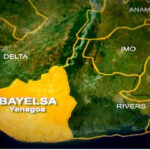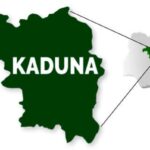“The right perspective asserts itself”, – E. D. Morel
The corridors of governments in Africa are littered with the fragments of abandoned policies and the debris of aborted projects. Existential projects like water transfers do not readily find acceptance either because they seem too costly or are inherently long-term in nature, thus, liable to be derailed or de-funded at the whims of succeeding governments or international partners.
However, unfortunate such considerations may be, the fact remains that various important projects have been left to go to ruin in Africa and more so in Nigeria. Correcting such a lamentable prospect should not only be a patriotic endeavour but also a matter of enlightened self-interest whereby value is created in place of abandoned hopes and lost causes.
In this era of “Renewed Hope” in Nigeria and the readiness that has been demonstrated by the Tinubu-Kashim administration toward embarking on really significant projects, imagining that the recharging of the Lake Chad could happen anytime soon would not be a forlorn hope, but a reality that could come into fruition.
Anthropogenic or climate-induced causes may be debated as academic questions of interest or curiosity, it however remains that the drying up and eventual disappearance of the Lake Chad is a FACT that is confronting us squarely in the face. For how long we have to wait for nature to take its course is not clear. But nature alone is not the only factor shaping the fate of Lake Chad today. Unhappily, man has also left his destructive marks in the Chad Basin, with sustained depletion of forest resources and other vegetation covers in the region, leading to the acceleration of the drying up of the Lake and the degrading of the basin’s fragile ecosystem.
The 2018 International Conference on the Lake Chad held in Abuja was aimed at saving the lake from total extinction. As things stand today, this is a possibility that cannot be discountenanced as improbable or even impossible. Experts from across the world brought together by the conference were unanimous in their opinion about saving Lake Chad. They were also of the view that the situation had reached a critical point that required drastic and immediate action to arrest and reverse the much-feared drying up of the Lake. If any credit is due to an individual for this initiative, the erstwhile Executive Secretary of the Commission, Engineer Sanusi Imran, should be applauded for spearheading the conference.
A few facts highlighted during the conference included the need for sustained and credible data gathering and analysis as indispensable components of any actions that might be taken to address the recharging of the Lake. The anthropogenic impacts on the Lake’s current condition were also highlighted, while agriculture and the exponential increase in human population in the area at that time estimated at between 45 million to 50 million people were said to have put a very considerable pressure on the Lake’s environment thereby causing or accelerating its shrinkage.
Other important issues that emerged during the proceedings also included the need for adaptation strategies to deal with human activities in the area, as well as the need to undertake extensive scientific studies to determine the biodiversity situation of the Lake Chad from the microbial level to its flora and fauna etc.
Sometimes answers to complex problems may be found in simple and conventional solutions that are actually in plain sight and readily within reach. Somehow, we tend to propose complex solutions to complex issues, believing that the more abstruse a problem, the more difficult the proposition that we have to put forward to rectify or address that problem. This seems to be the case in the matter of the Lake Chad recharging scheme. The transfer of water from the Congo Basin in the south to replenish and recharge the Lake Chad in the north to prevent it from going extinct is a Pan-Africanist endeavour whose magnitude and significance cannot be over-exaggerated.
Africa is not used to executing large-scale projects of continental significance. Isolated sub-regional projects may have been undertaken in the past, but a project of such a magnitude and importance has never been attempted to the best of my knowledge. The creation of a vision that has been in the African mind since the 1960s at the dawn of independence in the continent, was linked to the exploitation of the Congo Basin as the premier centre for regeneration of Africa, through infrastructure development driven by electricity generated from the Congo.
The Grand Inga Dam project was, therefore, conceived as an impetus for the electrification of Africa and the provision of the much needed but manifestly lacking industrial capacity across the continent.
Similarly, the transfer of water from Central Africa by way of the Ubangi-Chari Rivers into the Lake Chad is another visionary project that is waiting to become a reality. How far such a vision can be realised depends largely on the ability to address the projected cost and technical and engineering complexities that are entailed in it. The Ubangi River as the source of water to replenish Lake Chad has almost been decided and settled.
However, by what means such an undertaking could be accomplished is a different matter that still begs for answers. This and other factors being the paramount difficulties about such projects, the most logical question to ask is – can there be another alternative to the approaches that have been proposed?
Proposals for inter-basin water transfers have been on the table for several decades now, since it was first mooted by the German architect Herman Sorgel in 1929.
Over the years, dozens of water transfer schemes have been undertaken all over the world with various degrees of success and alternating consequences. Concerned by the fate awaiting Lake Chad, the member states of the Lake Chad Basin Commission (LCBC) decided in January 2002 to deliberate on possible remedies to be adopted.
The proposal to transfer water from Central African rivers was put forward and subsequently, full scale studies were commissioned. In 2011 the Canadian firm CIMA produced a feasibility study for the LCBC that suggested the pumping of water from Ubangi River, a tributary of the River Congo into Lake Chad. The proposal costing about $10 billion at the time, contained a plan to dam the river to create a source of energy to pump the water 180 meters uphill.
Other variant proposals were also produced, testifying to the numerous possibilities that are available towards recharging Lake Chad from Central Africa. Damming the Kotto River which itself is a tributary of the Ubangi River, was one such alternative.
A more ambitious plan was the Transaqua Plan developed by the Italian firm Bonifica, which would involve the damming of several tributaries of the Ubangi River to create massive reservoirs to pump water to Lake Chad at a cost of $50 billion. Despite its cost, the Transaqua Plan seemed to have found merit with the LCBC and it was adopted as the most feasible plan at the Abuja International Conference in 2018. LCBC and the Italian government and other stakeholders have been discussing the plan but so far, I am not aware of the latest situation regarding its implementation.
At the same conference, another plan using solar power to pump water from Ubangi River to Lake Chad thereby removing the need for damming the river and also reducing the cost of the project considerably was submitted. The plan also addressed the environmental factors and fears about depletion of water flowing into the Grand Inga Dam as expressed by the Central African Republic and Democratic Republic of Congo.
This alternative idea was actually presented by my good friend Practising Engineer Guy Immega, a retired aerospace engineer from British Columbia, Canada. Engineer Immega’s story and connection with Lake Chad are interesting and very inspiring. He explored the Lake in a boat of his own construction in the 1960s as a young man serving in the Peace Corps in Nguigimi area of Niger Republic. His published account was among the few authoritative narratives about the Buduma people of the Lake Chad.
The “Lake Chad Development Options For Sustainable Agriculture, Employment and Regional Food Security”, of Engineer Immega envisioned the construction of a single or a series of solar power stations in the Sahel as alternatives to the construction of dams on any of the tributaries of the Ubangi River to pump water into the Lake Chad. Because the plan involved the use of submerged intakes, it would work during 7 to 10 months in a year, when the volume of the river would be at its highest.
Engineer Immega’s plan provided several solutions in one package, such as drastic reduction in the overall cost of the project, availability of sustainable power to pump the water into Lake Chad, provision of irrigation for communities along the route of the water transfer and overall improvement in the lives of peoples across Central Africa and the Lake Chad basin.
According to Engineer Immega, the “Solar IBWT for Lake Chad will provide employment, electricity and food security to sub-Saharan Africa. In addition, economic incentives for all participating nations should follow. One means of doing this is to declare the Lake Chad Basin to be an International Economic Development Zone, a free trade region for agriculture, fishing and commerce. Perhaps the Lake Chad Basin Commission could administer the region. Such a multilateral treaty will provide an example of international cooperation for the world”. Such grand visions are necessary to inspire us to reach new heights and aspire towards greater efforts in improving the lives of our people.
In the next and final instalment in the series, I shall explore two important proposals that have been submitted by some engineers to transfer water to Lake Chad from internal river systems in Nigeria, as alternatives to the inter-basin water transfer from Central Africa.

 Join Daily Trust WhatsApp Community For Quick Access To News and Happenings Around You.
Join Daily Trust WhatsApp Community For Quick Access To News and Happenings Around You.


